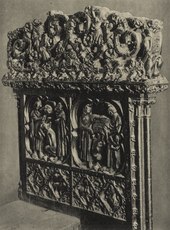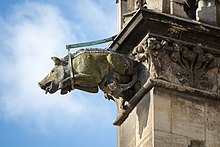Judensau at the choir stalls of Cologne Cathedral

The Judensau at the choir stalls of Cologne Cathedral is a medieval, antisemitic wood carving at the side of one of the seats in the choir of
The
Location

The
The woodcarvings of Judensau and of the blood libel are shown on the eastern, i.e. on the right hand side of the northern walkway. This area is normally roped-off, and may only be accessed on special occasions with a tour guide.
Manufacture
The choir stall of Cologne Cathedral is with 104 seats one of the largest in Germany. It was carved from 1308 to 1311 by craftsmen, whose names are not known anymore. The interior construction of the choir was completed by 1300, when the vaults were finished. The interior decoration was built subsequently, until the choir was inaugurated on 27 September 1322.[5]
Some of the 500 figures and ornaments were made by craftsmen from the
The Judensau and the other two wood carvings were probably made by a local man due to their unelaborate design and the unusual motif.[7]
Description


The Judensau and blood libel motifs are wooden reliefs, which fill side-by-side two quatrefoils. The quatrefoil on the left hand side shows three men, who can be distinguished as Jews by their Jewish hats. One of them lifts up the rear end of the pig, one feeds it and one sucks at one of its teats.[8][9]
The quatrefoil on the right hand side shows two Jews, who empty a tub, out of which a slaughtered pig and three piglets fall. The Jew on the right hand side leads a young boy to the scene, who can be distinguished as Christian because of a hint of a halo.[9][10]
A third relief on the other side of the armrest may be associated by its location and its motif with the other two. On a spandrel of the inner armrest are shown two pigs, which eat the leaves of an acorn. One of the two pigs jumped-up onto its rear legs and a third one sucks on one of its teats. A monk observes the scene from the background partially covered by a volute.[9][11]
Symbolism
The pig symbolises gluttony, vice or the devil in early Christian iconography. It was only disrespectfully associated with Jews in the 9th century. The caricature of Jews as pigs or Jews sucking at the teats or anus of a pig makes reference to the kashrut, according to which the consumption of pig products is prohibited.[12][13]
The historian Heribert Reiners described in 1909 the connection between the two motifs at the front. He interpreted that the Jews on the right hand side throw away the pork, which had been given to them by others, to look as if they were kosher. Their true immoderateness was shown in the scene on the left hand side, where they drink the milk of the pig.[10] Bernhard von Tieschowitz explained the scenes in 1930, while he highlighted that they are controversely interpreted. He concluded that both of them showed the blood libel, an accusation that Jews kidnapped and murdered the children of Christians in order to use their blood as part of their religious rituals during Jewish holidays.[14]
The Israeli art historian Isaiah Shachar interprets the scene on the right hand side, as if the Jews throw away the pork meat and kidnap a Christian child to be eaten. It could be a depiction of the alleged ritual murder of Werner of Oberwesel, who was killed in 1287. Shachar sees all three scenes relating to each other as a representation of vice and gluttony.[9]
Virtue opposes vice on many occasions in the choir stalls. In this case we find directly opposite two reliefs with the
Other antisemitic sculptures at Cologne Cathedral

On the back of the Shrine of the Three Kings (1190–1225) is a scene, which shows the flagellation of Jesus Christ by two henchmen with Jewish hats. It is interpreted not because of the hats, but because of the caricature-like distorted faces of the henchmen. It is probably one of the first examples of overemphasised Jewish noses as an anti-Jewish stereotype.[12]
An exterior cornice of one of the chapels of the cathedral is a gargoyle, which shows a squatting pig. At its teats suckles a male figurine, which depicts a Jew. It dates from around 1280.[12]
Controversy around the Judensau
In 2005, the Munich-based artists Wolfram P. Kastner and Günter Wangerin requested emphatically to remove the Judensau, or at least put up a sign with an explanation. In addition, they wanted two pieces of stone masonry approximately 50 metres (160 ft) tall, depicting two swastikas, to be removed. Kastner made repeated requests for their removal and staged acts of protest against the Christian church. The artists placed signs in front of Cologne Cathedral, in which they claimed "all Christians lie" (alle Christen lügen).[15][16]
The
In 2006, the controversy triggered a conference by the cathedral workshop in collaboration with the Karl-Rahner-Akademie with the title "Cologne Cathedral and 'the Jews'" (Der Kölner Dom und 'die Juden'). In 2008, the cathedral workshop and the Zentral-Dombau-Verein zu Köln dedicated a complete issue of the Kölner Domblatt to this topic and the results of the conference.[17]
Literature
- Ulrike Bergmann: Das Chorgestühl des Kölner Domes, Text and inventory (Jahrbuch 1986/1987 des Rheinischen Vereins für Denkmalpflege und Landschaftsschutz). Neuss: Neusser Druckerei und Verlag 1987, ISBN 3-88094-600-0.
- Ulrike Bergmann: Das Chorgestühl (Meisterwerke des Kölner Domes 3). Verlag Kölner Dom, Köln 1995, ISBN 3-922442-23-4(48 pages, many detailed photos).
- Ulrike Brinkmann and Rolf Lauer: Judendarstellungen im Kölner Dom. In: Kölner Domblatt 2008, 73rd Volume, pages 13–58, ISBN 978-3-922442-65-3.
- Georg Bönisch: Bartholomäusnacht am Rhein. In: Spiegel Geschichte 2015, Heft 1, pages 80–83, ISSN 1868-7318, DigitalisatPDF 1,4 MB.
- Bernd Wacker and Rolf Lauer (editors): Der Kölner Dom und ›die Juden‹. Conference of the Karl Rahner Akademie Köln in collaboration with the mason's lodge of Cologne from 18 to 19 November 2006. (Kölner Domblatt 2008, 73rd Volume). Cologne: Verlag Kölner Dom, ISBN 978-3-922442-65-3.
- Isaiah Shachar: The Judensau. A Medieval Anti-Jewish Motif and its History. Warburg Institute, London 1974, ISBN 0-85481-049-8.
- Bernhard von Tieschowitz: Das Chorgestühl des Kölner Domes. Marburg: Verlag des Kunstgeschichtlichen Seminars der Universität Marburg 1930.
External links
- Georg Bönisch: Bartholomäusnacht am Rhein, PDF 1,4 MB, retrieved 18 July 2017. Über den ersten beiden Seiten ein aktuelles Farbfoto der "Judensau".
- Marc Steinmann: Wange NC Westen, Judensau, auf www.koelner-dom.de, downloaded on 7 October 2017.
References
- ^ Concordat Watch: The Judensau (Jews' sow) on mediaeval churches.
- ISBN 978-0-231-08275-4.
- ISBN 0854810498.
- ^ "Zionism and Israel - Encyclopedic Dictionary: Judensau". zionism-israel.com. Retrieved 7 February 2015.
- ^ Ulrike Bergmann: Das Chorgestühl des Kölner Domes, Textband, S. 11–23.
- ^ Ulrike Bergmann: Das Chorgestühl des Kölner Domes, Textband, S. 59–66.
- ^ Ulrike Bergmann: Das Chorgestühl des Kölner Domes, Textband, S. 107.
- ^ a b Ulrike Bergmann: Das Chorgestühl des Kölner Domes, Textband, S. 96.
- ^ a b c d Isaiah Shachar: The Judensau, S. 24–25, Fußnoten S. 78–79, Tafeln 16b und 17.
- ^ a b Heribert Reiners: Die rheinischen Chorgestühle der Frühgotik. Ein Kapitel der Rezeption der Gotik in Deutschland (= Studien zur deutschen Kunstgeschichte, 113. Heft). Heitz & Mündel, Straßburg 1909, S. 64, Tafel XIX, Digitalisat, PDF 9,5 MB.
- ^ Bernhard von Tieschowitz: Das Chorgestühl des Kölner Domes, S. 10, Tafel 21b.
- ^ a b c Ulrike Brinkmann und Rolf Lauer: Judendarstellungen im Kölner Dom. In: Bernd Wacker und Rolf Lauer (Hrsg.): Der Kölner Dom und ›die Juden‹, S. 13–58.
- ^ Marten Marquardt: Judenfeindschaft in der christlichen Kunst am Beispiel der Kölner Judensau. In: epd Dokumentation, Nr. 10 3 March 2003, S. 40–45, Online PDF Archived 2017-09-30 at the Wayback Machine (gesamter Band), 1,1 MB.
- ^ Bernhard von Tieschowitz: Das Chorgestühl des Kölner Domes, S. 9, Tafel 15.
- ^ a b Susanne Gannott: Sauerei im Dom. In: die tageszeitung 19 November 2005, S. 4.
- ^ Wolfram P. Kastner: Alle Christen lügen. Flugblatt, undatiert, c. 2005, Online PDF, 96 kB.
- ^ Sandra Kiepels: Kölner Domblatt: Der Kölner Dom und die Juden. In: Kölner Stadtanzeiger 19 December 2008.
